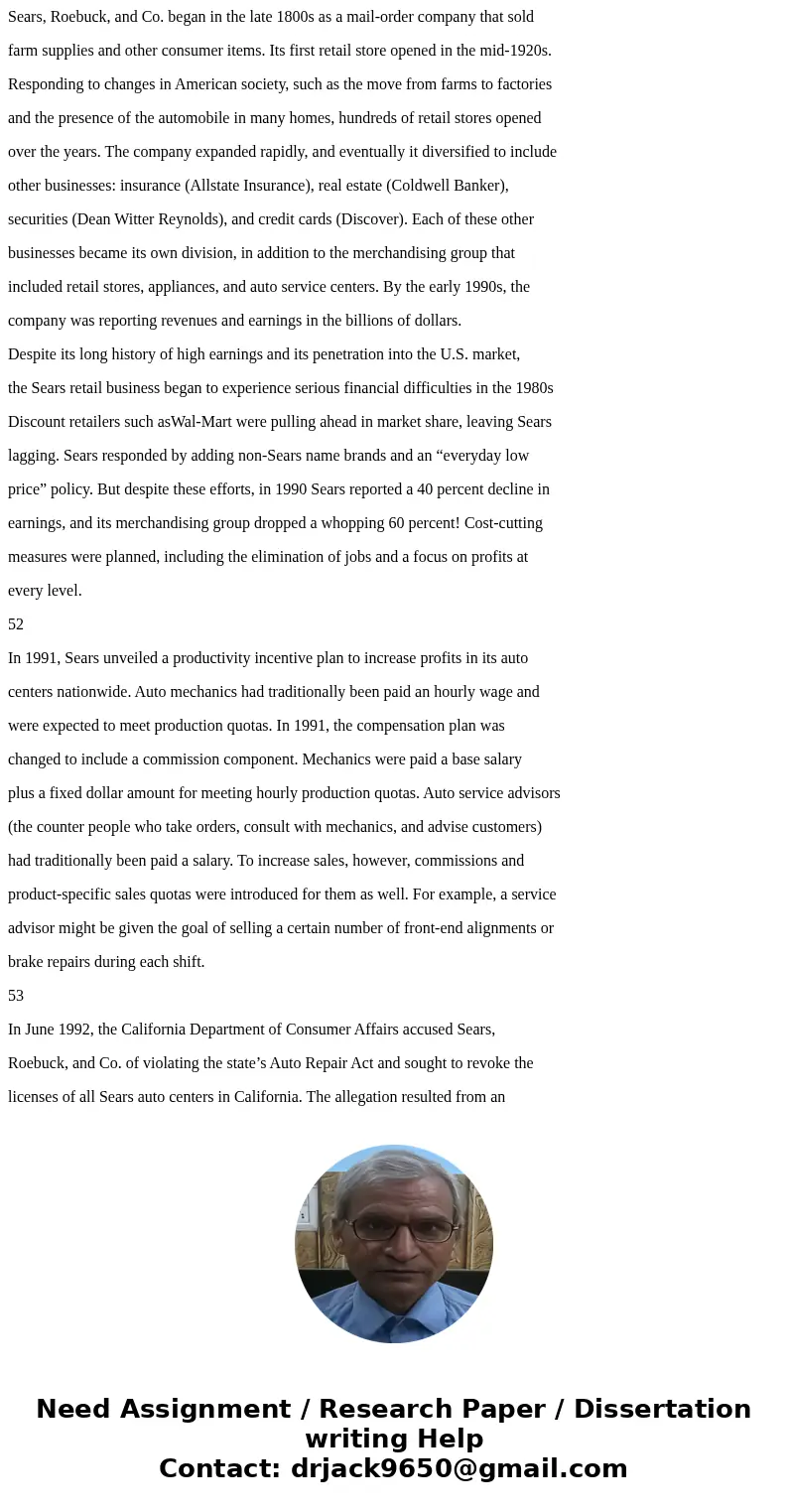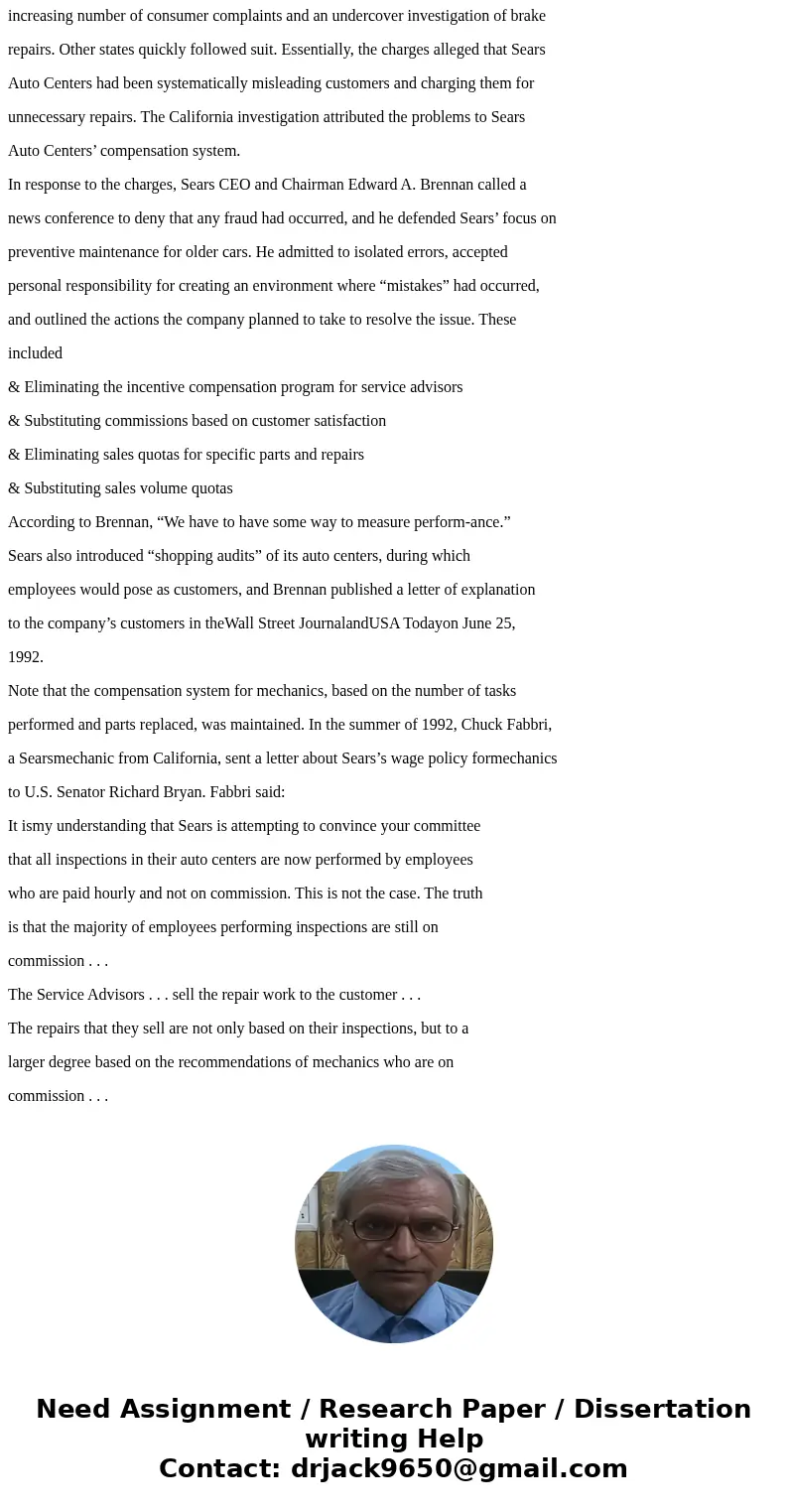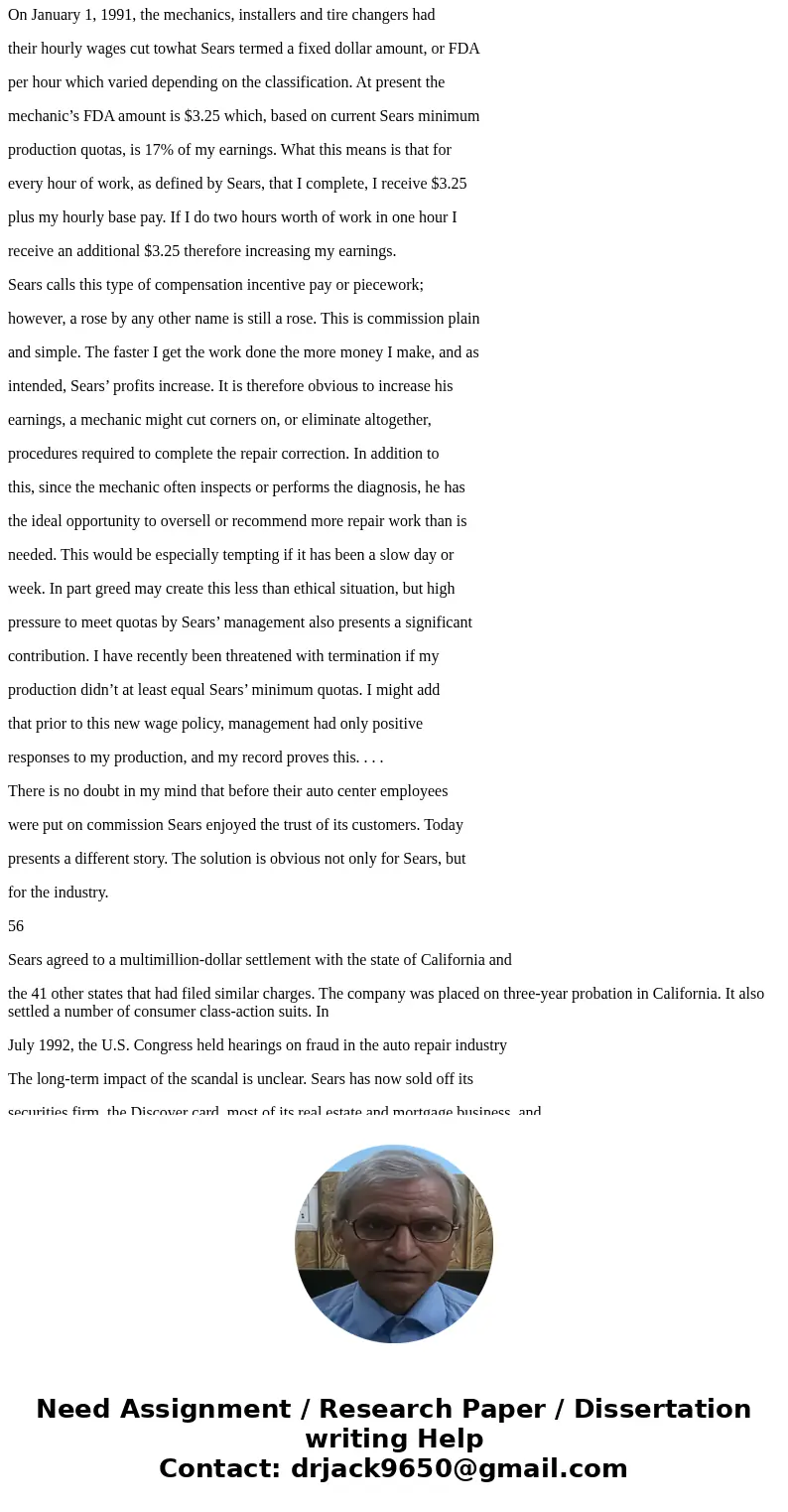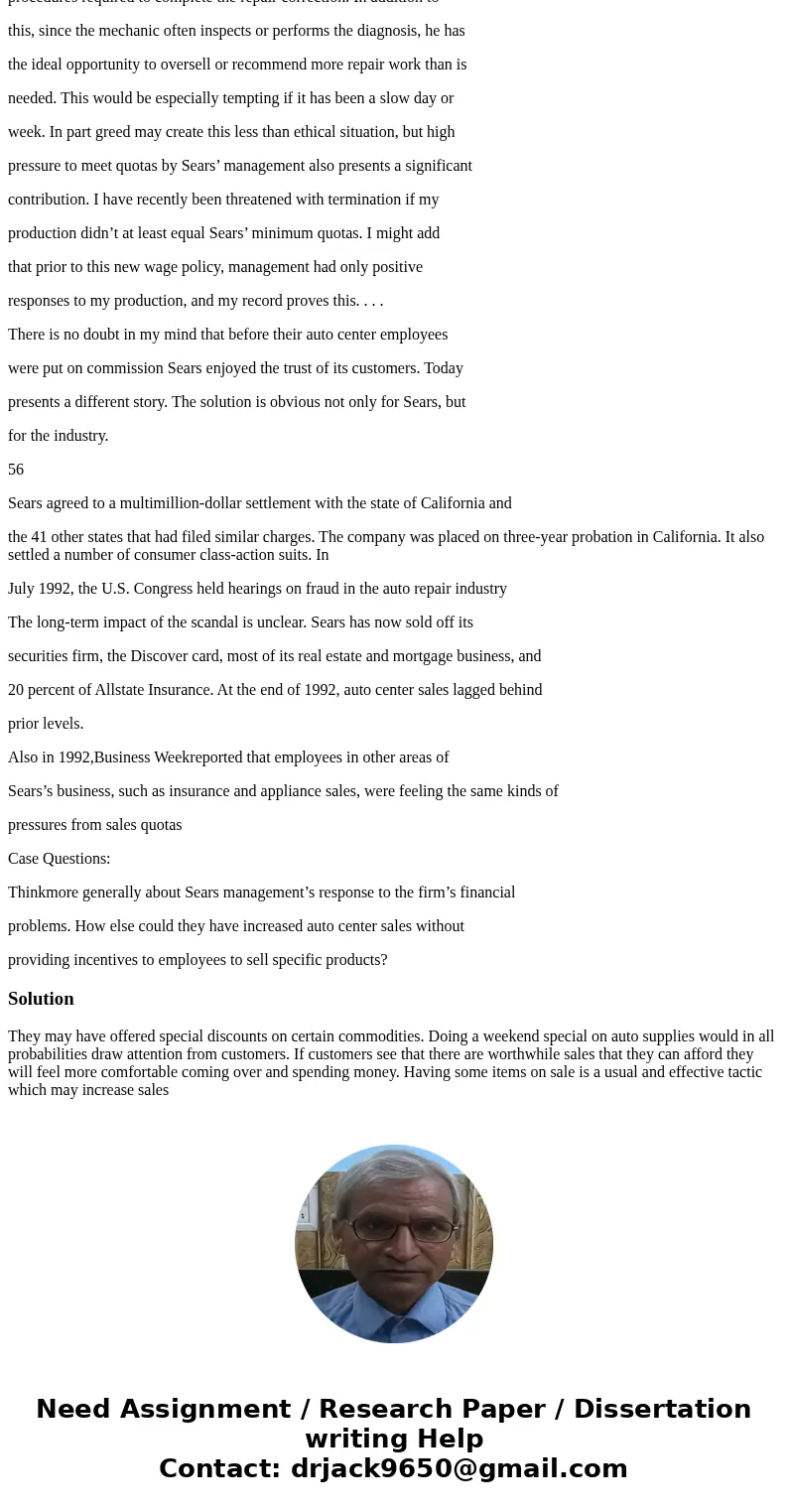Sears Roebuck and Co began in the late 1800s as a mailorder
Sears, Roebuck, and Co. began in the late 1800s as a mail-order company that sold
farm supplies and other consumer items. Its first retail store opened in the mid-1920s.
Responding to changes in American society, such as the move from farms to factories
and the presence of the automobile in many homes, hundreds of retail stores opened
over the years. The company expanded rapidly, and eventually it diversified to include
other businesses: insurance (Allstate Insurance), real estate (Coldwell Banker),
securities (Dean Witter Reynolds), and credit cards (Discover). Each of these other
businesses became its own division, in addition to the merchandising group that
included retail stores, appliances, and auto service centers. By the early 1990s, the
company was reporting revenues and earnings in the billions of dollars.
Despite its long history of high earnings and its penetration into the U.S. market,
the Sears retail business began to experience serious financial difficulties in the 1980s
Discount retailers such asWal-Mart were pulling ahead in market share, leaving Sears
lagging. Sears responded by adding non-Sears name brands and an “everyday low
price” policy. But despite these efforts, in 1990 Sears reported a 40 percent decline in
earnings, and its merchandising group dropped a whopping 60 percent! Cost-cutting
measures were planned, including the elimination of jobs and a focus on profits at
every level.
52
In 1991, Sears unveiled a productivity incentive plan to increase profits in its auto
centers nationwide. Auto mechanics had traditionally been paid an hourly wage and
were expected to meet production quotas. In 1991, the compensation plan was
changed to include a commission component. Mechanics were paid a base salary
plus a fixed dollar amount for meeting hourly production quotas. Auto service advisors
(the counter people who take orders, consult with mechanics, and advise customers)
had traditionally been paid a salary. To increase sales, however, commissions and
product-specific sales quotas were introduced for them as well. For example, a service
advisor might be given the goal of selling a certain number of front-end alignments or
brake repairs during each shift.
53
In June 1992, the California Department of Consumer Affairs accused Sears,
Roebuck, and Co. of violating the state’s Auto Repair Act and sought to revoke the
licenses of all Sears auto centers in California. The allegation resulted from an
increasing number of consumer complaints and an undercover investigation of brake
repairs. Other states quickly followed suit. Essentially, the charges alleged that Sears
Auto Centers had been systematically misleading customers and charging them for
unnecessary repairs. The California investigation attributed the problems to Sears
Auto Centers’ compensation system.
In response to the charges, Sears CEO and Chairman Edward A. Brennan called a
news conference to deny that any fraud had occurred, and he defended Sears’ focus on
preventive maintenance for older cars. He admitted to isolated errors, accepted
personal responsibility for creating an environment where “mistakes” had occurred,
and outlined the actions the company planned to take to resolve the issue. These
included
& Eliminating the incentive compensation program for service advisors
& Substituting commissions based on customer satisfaction
& Eliminating sales quotas for specific parts and repairs
& Substituting sales volume quotas
According to Brennan, “We have to have some way to measure perform-ance.”
Sears also introduced “shopping audits” of its auto centers, during which
employees would pose as customers, and Brennan published a letter of explanation
to the company’s customers in theWall Street JournalandUSA Todayon June 25,
1992.
Note that the compensation system for mechanics, based on the number of tasks
performed and parts replaced, was maintained. In the summer of 1992, Chuck Fabbri,
a Searsmechanic from California, sent a letter about Sears’s wage policy formechanics
to U.S. Senator Richard Bryan. Fabbri said:
It ismy understanding that Sears is attempting to convince your committee
that all inspections in their auto centers are now performed by employees
who are paid hourly and not on commission. This is not the case. The truth
is that the majority of employees performing inspections are still on
commission . . .
The Service Advisors . . . sell the repair work to the customer . . .
The repairs that they sell are not only based on their inspections, but to a
larger degree based on the recommendations of mechanics who are on
commission . . .
On January 1, 1991, the mechanics, installers and tire changers had
their hourly wages cut towhat Sears termed a fixed dollar amount, or FDA
per hour which varied depending on the classification. At present the
mechanic’s FDA amount is $3.25 which, based on current Sears minimum
production quotas, is 17% of my earnings. What this means is that for
every hour of work, as defined by Sears, that I complete, I receive $3.25
plus my hourly base pay. If I do two hours worth of work in one hour I
receive an additional $3.25 therefore increasing my earnings.
Sears calls this type of compensation incentive pay or piecework;
however, a rose by any other name is still a rose. This is commission plain
and simple. The faster I get the work done the more money I make, and as
intended, Sears’ profits increase. It is therefore obvious to increase his
earnings, a mechanic might cut corners on, or eliminate altogether,
procedures required to complete the repair correction. In addition to
this, since the mechanic often inspects or performs the diagnosis, he has
the ideal opportunity to oversell or recommend more repair work than is
needed. This would be especially tempting if it has been a slow day or
week. In part greed may create this less than ethical situation, but high
pressure to meet quotas by Sears’ management also presents a significant
contribution. I have recently been threatened with termination if my
production didn’t at least equal Sears’ minimum quotas. I might add
that prior to this new wage policy, management had only positive
responses to my production, and my record proves this. . . .
There is no doubt in my mind that before their auto center employees
were put on commission Sears enjoyed the trust of its customers. Today
presents a different story. The solution is obvious not only for Sears, but
for the industry.
56
Sears agreed to a multimillion-dollar settlement with the state of California and
the 41 other states that had filed similar charges. The company was placed on three-year probation in California. It also settled a number of consumer class-action suits. In
July 1992, the U.S. Congress held hearings on fraud in the auto repair industry
The long-term impact of the scandal is unclear. Sears has now sold off its
securities firm, the Discover card, most of its real estate and mortgage business, and
20 percent of Allstate Insurance. At the end of 1992, auto center sales lagged behind
prior levels.
Also in 1992,Business Weekreported that employees in other areas of
Sears’s business, such as insurance and appliance sales, were feeling the same kinds of
pressures from sales quotas
Case Questions:
Thinkmore generally about Sears management’s response to the firm’s financial
problems. How else could they have increased auto center sales without
providing incentives to employees to sell specific products?
Solution
They may have offered special discounts on certain commodities. Doing a weekend special on auto supplies would in all probabilities draw attention from customers. If customers see that there are worthwhile sales that they can afford they will feel more comfortable coming over and spending money. Having some items on sale is a usual and effective tactic which may increase sales




 Homework Sourse
Homework Sourse